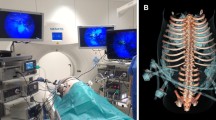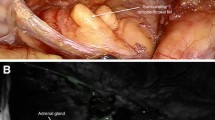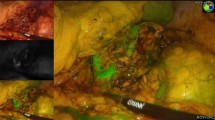Abstract
Background
Identification of adrenal glands from the surrounding structures during laparoscopic surgery can be challenging especially in obese individuals. This can increase the chances for hemorrhage and conversion to open surgery. We present the first report of fluorescent infrared visualization of the adrenal glands in a large animal model.
Methods
Five adult Yorkshire pigs were utilized for the study, in compliance with the animal study regulations. After an intravenous bolus administration of 3 mL of indocyanine green (ICG), visualization was performed with a xenon/infrared light source and a laparoscope with a charge-coupled filter device. Activation of the device was done with a foot pedal. Images were analyzed using histogram software and the difference of enhancement was statistically analyzed using unpaired two-tailed t test.
Results
The right adrenal glands were visualized in all five animals immediately after administering ICG. Fluorescence facilitated demarcation of adrenal gland tissue from surrounding adipose tissue. Peritoneum and fat was visualized in black color. Adrenal enhancement lasted for 4 h in all cases. The mean value for adrenal fluorescence using histogram count was 71.75 pixels, and for adrenal xenon was 168.87 pixels (p = 0.0002; 95 % CI −130.93 to −0.63). The mean value for fat fluorescence using histogram count was 5.54 pixels and fat xenon was 187.15 pixels (p = 0.0001; 95 % CI −199.39 to −163.82). Although there was no significant difference between adrenal and fat enhancement with xenon light (p = 0.24; 95 % CI −15.53 to 52.09), the difference became significant between adrenal and fat fluorescence (p = 0.0001; 95 % CI 48.51–83.9).
Conclusion
Fluorescence imaging appears to be a feasible and easy method to differentiate adrenal glands from the surrounding tissue in a large animal model. Further studies are necessary to investigate the real application of this method during laparoscopic adrenalectomy in humans.






Similar content being viewed by others
References
Assalia A, Gagner M (2004) Laparoscopic adrenalectomy. Br J Surg 91(10):1259–1274
Gagner M, Lacroix A, Bolte E (1992) Laparoscopic adrenalectomy in Cushing’s syndrome and pheochromocytoma. N Engl J Med 327(14):1033
Bittner JG 4th, Gershuni VM, Matthews BD, Moley JF, Brunt LM (2013) Risk factors affecting operative approach, conversion, and morbidity for adrenalectomy: a single-institution series of 402 patients. Surg Endosc 27(7):2342–2350
Dancea HC, Obradovic V, Sartorius J, Woll N, Blansfield JA (2012) Increased complication rate in obese patients undergoing laparoscopic adrenalectomy. JSLS/Soc Laparoendosc Surg 16(1):45–49
Sopinski J, Kuzdak K (2013) Navigation with use of intra-operative ultrasound in search for neoplastic lesions of endocrine glands. Polski Przeglad Chirurgiczny 85(5):262–270
Schols RM, Bouvy ND, van Dam RM, Stassen LP (2013) Advanced intraoperative imaging methods for laparoscopic anatomy navigation: an overview. Surg Endosc 27(6):1851–1859
Alander JT, Kaartinen I, Laakso A, Pätilä T, Spillmann T, Tuchin VV, Venermo M, Välisuo P (2012) A review of indocyanine green fluorescent imaging in surgery. Int J Biomed Imaging 2012:940585
Fox IJ, Wood EH (1960) Indocyanine green: physical and physiologic properties. Proc Staff Meet Mayo Clin 35:732–744
Ishizawa T, Bandai Y, Ijichi M, Kaneko J, Hasegawa K, Kokudo N (2010) Fluorescent cholangiography illuminating the biliary tree during laparoscopic cholecystectomy. Br J Surg 97(9):1369–1377
Ishizawa T, Bandai Y, Kokudo N (2009) Fluorescent cholangiography using indocyanine green for laparoscopic cholecystectomy: an initial experience. Arch Surg 144(4):381–382
Smith CD, Weber CJ, Amerson JR (1999) Laparoscopic adrenalectomy: new gold standard. World J Surg 23(4):389–396
Verbeek FP, Schaafsma BE, Tummers QR, van der Vorst JR, van der Made WJ, Baeten CI, Bonsing BA, Frangioni JV, van de Velde CJ, Vahrmeijer AL, Swijnenburg RJ (2013) Optimization of near-infrared fluorescence cholangiography for open and laparoscopic surgery. Surg Endosc 28(4):1076–1082
Schols RM, Bouvy ND, Masclee AA, van Dam RM, Dejong CH, Stassen LP (2013) Fluorescence cholangiography during laparoscopic cholecystectomy: a feasibility study on early biliary tract delineation. Surg Endosc 27(5):1530–1536
Dip FD, Asbun D, Rosales-Velderrain A, Menzo EL, Simpfendorfer CH, Szomstein S, Rosenthal RJ (2014) Cost analysis and effectiveness comparing the routine use of intraoperative fluorescent cholangiography with fluoroscopic cholangiogram in patients undergoing laparoscopic cholecystectomy. Surg Endosc. 28(6):1838–1843
Tobis S, Knopf JK, Silvers CR, Marshall J, Cardin A, Wood RW, Reeder JE, Erturk E, Madeb R, Yao J, Singer EA, Rashid H, Wu G, Messing E, Golijanin D (2012) Near infrared fluorescence imaging after intravenous indocyanine green: initial clinical experience with open partial nephrectomy for renal cortical tumors. Urology 79(4):958–964
Ishizawa T, Masuda K, Urano Y, Kawaguchi Y, Satou S, Kaneko J, Hasegawa K, Shibahara J, Fukayama M, Tsuji S, Midorikawa Y, Aburatani H, Kokudo N (2014) Mechanistic background and clinical applications of indocyanine green fluorescence imaging of hepatocellular carcinoma. Ann Surg Oncol 21(2):440–448
Liu DZ, Mathes DW, Zenn MR, Neligan PC (2011) The application of indocyanine green fluorescence angiography in plastic surgery. J Reconstr Microsurg 27(6):355–364
Diana M, Noll E, Diemunsch P, Dallemagne B, Benahmed MA, Agnus V, Soler L, Barry B, Namer IJ, Demartines N, Charles AL, Geny B, Marescaux J (2013) Enhanced-reality video fluorescence: a real-time assessment of intestinal viability. Ann Surg 259(4):700–707
Harke N, Schoen G, Schiefelbein F, Heinrich E (2013) Selective clamping under the usage of near-infrared fluorescence imaging with indocyanine green in robot-assisted partial nephrectomy: a single-surgeon matched-pair study. World J Urol. doi:10.1007/s00345-013-1202-4
Speich R, Saesseli B, Hoffmann U, Neftel KA, Reichen J (1988) Anaphylactoid reactions after indocyanine-green administration. Ann Intern Med 109(4):345–346
Onoda S, Azumi S, Hasegawa K, Kimata Y (2013) Preoperative identification of perforator vessels by combining MDCT, Doppler flowmetry, and ICG fluorescent angiography. Microsurgery 33(4):265–269
Acknowledgments
This study was made possible by an educational grant from KARL STORZ Endoskope, Tuttlingen, Germany. We thank Ray I Gonzales and Leonardo Real for the assistance in the Lab.
Disclosures
Fernando Dip, Mayank Roy, Steven Perrins, Rama Rao Ganga, Emanuele Lo Menzo, Samuel Szomstein, Raul Rosenthal have no conflicts of interest to disclose.
Author information
Authors and Affiliations
Corresponding author
Rights and permissions
About this article
Cite this article
Dip, F.D., Roy, M., Perrins, S. et al. Technical description and feasibility of laparoscopic adrenal contouring using fluorescence imaging. Surg Endosc 29, 569–574 (2015). https://doi.org/10.1007/s00464-014-3699-z
Received:
Accepted:
Published:
Issue Date:
DOI: https://doi.org/10.1007/s00464-014-3699-z




